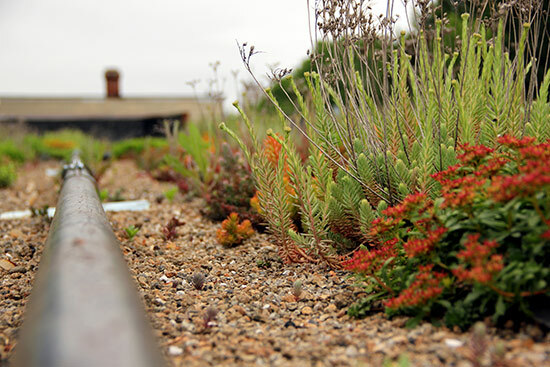Benefits of green infrastructure can outweigh costs
Green infrastructure can save money, clean our air and water, and offer residents social gains.
Green roofs, porous pavement and other tools of the green infrastructure trade can be a cost-effective way to control stormwater runoff, according to a U.S. Environmental Protection Agency (EPA) report that estimates the benefits of Lancaster City’s long-term green infrastructure plan.

Image courtesy Lindsayy/Flickr
Located in south-central Pennsylvania, Lancaster City has a population approaching 60,000. Each year, combined sewer overflows send almost 750 million gallons of stormwater runoff and untreated waste into the Conestoga River, pushing excess nutrients into the tributary of the Chesapeake Bay. In an effort to combat this pollution problem, the city released a green infrastructure plan in 2011 that outlines the tree plantings, parking lot excavations and other projects that will be put in place over the next 25 years.
While the plan lists the water quality benefits the city expects to see—including the reduction of stormwater runoff by more than 1 billion gallons per year—it is, for some, an incomplete assessment. So, in a report released this week, the EPA furthered the city’s benefits analysis by addressing the additional environmental, social and economic benefits that green infrastructure can provide.

According to the report, the long-term implementation of green infrastructure in Lancaster City could save $120 million in avoided gray infrastructure capital costs and earn close to $5 million in annual benefits. Green infrastructure would reduce air pollution, energy use and stormwater runoff, and offer residents a boost in property values, recreational opportunities and other qualitative benefits. With a forecasted implementation cost of between $51.6 and $94.5 million, it is clear the benefits of green infrastructure exceed the costs.
While gray infrastructure uses tanks and pipes to trap and dispose of rainwater, green infrastructure uses soil and vegetation to manage rainwater where it falls. A combination of green and gray infrastructure has proven effective for Lancaster City, and similar plans could benefit communities across the watershed.

One reconstructed parking lot, for instance, incorporated almost 6,000 square feet of bioretention and infiltration practices on South Plum Street, with an estimated annual benefit of more than $1,100. A commercial green street in northeast Lancaster incorporated bioretention and infiltration practices as well as permeable pavement, with an estimated annual benefit of more than $2,300. And an urban park redeveloped with a host of green infrastructure practices carries an estimated annual benefit of more than $5,500.
“Valuing multiple benefits of green infrastructure ensures water management investments by the city will help… provide a safer, healthier and more prosperous community,” said Liz Deardorff, Clean Water Supply director at American Rivers, in a media release. “The results of this study affirm that green infrastructure has multiple benefits for both large and small cities needing to reduce pollution and ensure clean water.”
From the Field: Capturing stormwater naturally in Lancaster, Pennsylvania from Chesapeake Bay Program on Vimeo.

Comments
There are no comments.
Thank you!
Your comment has been received. Before it can be published, the comment will be reviewed by our team to ensure it adheres with our rules of engagement.
Back to recent stories